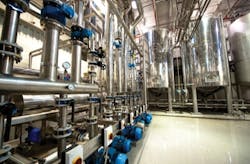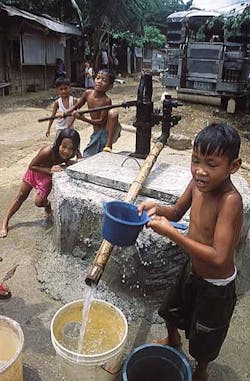Funding 'Water For All' Across Asia
Over 170 million people now have access to water and sanitation thanks to support from the Asian Development Bank. Yet how much of a priority is water for the bank's $17.5 billion budget compared to other urgent infrastructure requirements, such as schools and roads? Monty LeFrance investigates.
Amy Leung is chair of the Asian Development Bank's (ADB) Water Community of Practice and heads up the Southeast Asia Regional Department. She points out that, thanks to ADB, about 170 million people have been provided access to water supply services under the Water Financing Program from 2006 to date.
She would be the first to admit, however, that while the work of ADB is fair and transparent, its procedures can be both cumbersome and slow. Such is the price of working in a large organisation. And when it comes to issues of size, it doesn't get much bigger than ADB.
ADB's Leung says that water stress is one of the biggest challenges facing the bank
As she walks into her office in Manila, Philippines, every day she is greeted by ADB's slogan: 'Fighting Poverty in Asia and the Pacific'. Is this a hollow catch-phrase or something in which she can really immerse herself and truly believe?
"I absolutely do feel it, yes. This is the main incentive and motivating force for most of us here at ADB, that we are doing something worthwhile for the less advantaged and vulnerable through practical projects on the ground. We involve as many people as we can in every project - from stakeholders to beneficiaries - and especially in plans relating to water supply. So when water is indeed supplied once the tap is connected, and you can see people actually benefitting from safe, clean water; well, it's difficult for me to describe just how satisfying and rewarding that is."
Water challenges
Established in the mid 1960s, the bank has a massive budget of $17.5 billion in approved financing - administered by no less than 2,800 employees from 59 countries. The brief seldom varies: to deliver projects that create economic and development impact. It's range of armoury? Loans, grants, policy dialogue, technical assistance and equity investments. It might well have built tens of thousands of schools and constructed or upgraded almost 30,000 kms of national highways and roads - but what is ADB's greatest challenge in respect of water?
The Water Financing Program has an initial focus on six countries: China, India, Indonesia, Pakistan, the Philippines and Vietnam – nations which account for 80% of ADB's water operations
"It's the issue of water stress without a shadow of doubt," she replies. "Simply put, demand is much higher than supply in terms of good water. Agriculture and industry are big consumers, of course, so the efficient use of water allocation is clearly critical. The different challenges cannot be neatly compartmentalised, though, because a lot of untreated water is returned to rivers polluted. So pollution is also an overriding concern." ADB's newly approved 'Water Operational Plan 2011–2020' confirms Leung's analysis, affirming that water stress "affects the region's food and energy production, and its ecological needs, and adversely impacts on the health and livelihoods of its populations". It adds that demand for water is increasing "because of rapid economic development, increasing urbanisation, and the large growth in population and its impacts on food production".
The lack of adequate sanitation and robust wastewater management clearly also compounds matters, the plan goes on to argue, by contributing to the unchecked pollution of accessible freshwater and thereby adversely affecting the health and welfare of many millions of people in the region.
Private sector participation
Leung's own international background seems to fit seamlessly with her ADB brief. With over 20 years of experience in managing multi-stakeholder and multi-disciplinary projects in Canada, Hong Kong, Indonesia, China, the Philippines and Uzbekistan, she is, unsurprisingly perhaps, more than receptive to public-private partnerships.
"We don't work directly with the big players in the water industry because our clients are the developing countries themselves. Our mandate is to work with them to improve the performance of water utilities - for example by reducing non-revenue water, complying with WHO [World Health Organisation] standards, improving asset management and so on.
"In this regard public-private partnerships can be helpful. Because a private enterprise, with its eye keenly focussed on the bottom line, is obliged to manage things more efficiently than the public sector. So I do believe that the pursuit of profits and the reduction of poverty can go hand in hand. It can be a win-win situation.
"It all depends on how a particular contract is structured. If the contract is drafted so that it ensures that services will reach the poor and if the government, in turn, is prepared to subsidise water supply, then this can only be a good thing. The truth is that water is such a basic commodity that you cannot have a one-size-fits-all approach, certainly not in terms of price. This requires these two different sectors to come together. There are both good and bad examples – so one has to be cautious and not end up making broad, sweeping assertions."
ADB's Water Operational Plan reaffirms that partnerships have to "become more strategic and demonstrate their value addition." Still, ADB is determined to get the message out, loud and clear, that significantly increasing the private sector's participation in water and sanitation and wastewater management services will be critical on the grounds that "governments cannot risk waiting for investments to happen or for technological and managerial expertise to be secured only from within their own resources".
Focus countries and flood defences
What about the banking crisis and the prospect of a global recession? Matters might very well be focussed on the Eurozone at present but ADB is, after all, a bank and presumably not immune from the adverse impact of low growth and a poor economic outlook.
"There has not been a major impact; not for the moment, at least," Leung responds. "But our client countries are preparing themselves for whatever impact the global recession might have. In some respects, though, the Asian crisis of the late 1990s prepared many of them and they might be said to be ahead of the game. Still, we all know that we live in an inter-connected world and we have to be prepared for anything that might come our way."
Future Investment: China Projects
- Shanxi Integrated Agricultural Development in Valley and Watershed Areas
- Xinjiang Border Counties and Towns Infrastructure and Ecosystem Improvement
- Hebei Small Cities and Towns Development Demonstration Sector
- Guangxi Border Cities Development
- Chongging Urban-Rural Infrastructure Development Demonstration
- Liaoning Small Cities and Towns Development Demonstration Sector Project
- Shanxi Small Cities and Towns Development Demonstration Sector Project
- Wuhan Urban Environment Improvement.
"Water for All" is ADB's vision and policy for the Asia and Pacific region. But it is its Water Financing Program (WFP) which works to increase investments and support reforms in rural water, urban water, and river basin water. The WFP priority areas for investment are rural communities, cities and river basins. And while the WFP is open to all of ADB's developing member countries, its initial focus is on six countries: China, India, Indonesia, Pakistan, the Philippines and Vietnam. These countries represent 75% of the region's population and account for almost 80% of ADB's water operations.
Leung will also inform you that improving flood defences remains a key priority. And as if to provide evidence of the good work being carried out by ADB in this regard, she says that ADB's employees were working flat out to help Thailand and Cambodian flood victims cope via immediate relief operations and post flood rehabilitation support. ADB hastily ratified a $3 million grant each to support Cambodia and Thailand's efforts to recover from the floods that recently devastated the countries. More recently were the floods in the Philippines, declared by President Benigno Aquino as a national calamity after nearly 1000 people were reportedly killed by a typhoon. The ADB provided a $3 million grant to support emergency relief efforts.
When it comes to the allocation of resources towards issues as diverse as water and sanitation, experts such as Leung nevertheless have to fight their corner in a world of limited financial resources. Of course all aspects of development are complimentary. And the truth is that projects are determined by what particular national governments might apply for and deem to be their priorities, not pet projects on ADB water division's wish-list.
Pumped: Leung is confident that the water supply target in the Millennium Development Goals will be met in the Asia-Pacific region by 2015
The bottom line is that if money goes towards other worthy major infrastructure projects, such as energy and transportation, then there will clearly be less money in the ADB kitty for the likes of much needed flood defences and river restoration projects. As things stand water related projects account for approximately one fifth of ADB's budgeting.
Millennium Development Goals progress
The bank's projects are vast and too numerous to mention (see box out for future China projects) but include schemes as diverse as the West Jakarta Water Supply Development Project in Indonesia, the Chhattisgarh Irrigation Development Project in India, the Khatlon Province Flood Risk Management Project in Tajikistan and the Pasig River Environmental Management and Rehabilitation Sector Development Program in the Philippines, to name but a few of dozens of ongoing projects.
A similar amount are in the pipeline, working their way slowly but surely through the ADB's not inconsiderable bureaucracy. Once a loan has been agreed it then has to be processed. There then follows a sometimes baffling array of further hoops to jump through: issues relating to due diligence, technical, viability, finance, economics, social and so on.
ADB does goes out of its way, however, to ensure that the issues of water, health and education are not over compartmentalised and come to be viewed as separate and distinct worlds.
"This is not the case at all, because in reality they are all very much interlinked. When it comes to water projects," Leung explains, "one of the major indicators is health impact, so we often try to persuade governments about the importance of educational awareness campaigns too. Water, sanitation and health; to me these subjects are indivisible."
What about that other well known ADB slogan, then, 'Water for All'? Leung remains confident that this can become a reality within an Asian context.
"We are already doing well in relation to meeting the Millennium Development Goal (MDG) targets and I remain confident that we are going to achieve water supply in the Asia Pacific region by 2015. Everyone has the right to clean water. We are doing well here in this region. I have seen real and genuine progress with my own eyes over the years of working with ADB. But please do not misunderstand me. I am not remotely complacent on the grounds that there remains so very much to be done."
Author's note:Monty LeFrance is a freelance correspondent for Water & Wastewater International magazine. For further information please contact the chief editor Tom Freyberg: [email protected].
More Water & WasteWater International Current Issue Articles
More Water & WasteWater International Archives Issue Articles



